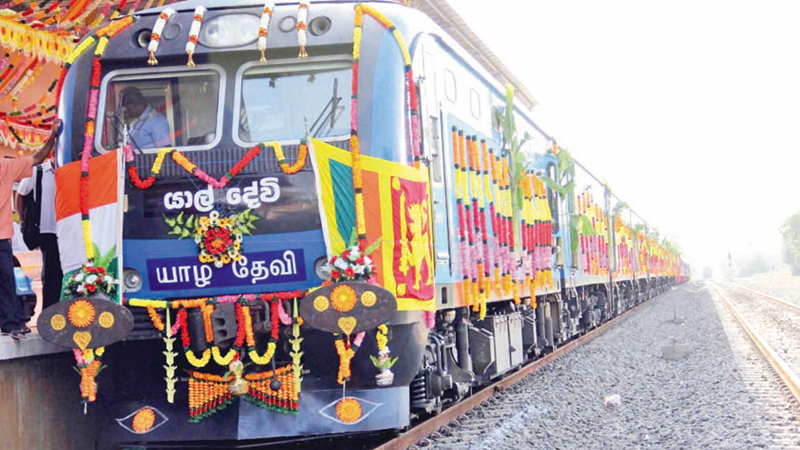· Rs. 4,500 million allocated under Indian Credit Line to upgrade railway signalling system
· Travel time of North-bound trains will be reduced
“The Yal Devi Express train on Platform-3 leaves for Kankesanturai at 6:00 a.m. The train stops at Ragama, Polgahawela, Kurunegala, Mahawa Junction, Galgamuwa, Anuradhapura, Medawachchiya, Vavuniya…….’’ The announcement was first heard on Monday, April 23, 1956 at Colombo Fort Railway Station where Yal Devi’s (Jaffna Queen) maiden journey began.
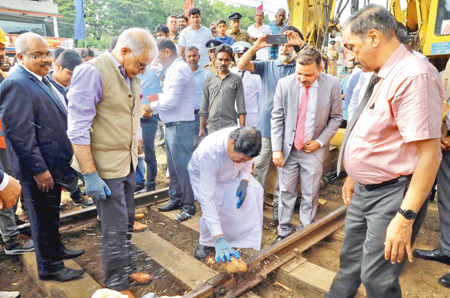
Transport, Highways and Mass Media Minister Dr. Bandula Gunawardena dashing a coconut at the Galgamuwa Railway Station to symbolise the commencement of work on the railway line. Indian High Commissioner Santosh Jha is also in the picture.
Later, other stations like Weyangoda and Tambuttegama were added to Yal Devi’s journey and today there are Inter-City Express trains that are faster than the Yal Devi.
Many trains travel from the North to the South and vice versa, but there is no other name as established as Yal Devi.
The construction work of the Northern Railway line began on February 14, 1894. Passenger trains on the route started in 1905/1906, with the Night Mail train service. In addition to the Night Mail train which took nearly 12 hours, there was a need for a daytime train and the Yal Devi train was added.
It took seven hours and 20 minutes for the Yal Devi to travel from Colombo to Jaffna in 1956. It used an M-2 class locomotive imported from Canada under the Colombo Plan. Its speed increased after the deployment of M4 class locomotives imported from Canada in 1975. Most of these locomotives which bear the names of well-known Canadian cities are still working.
The Yal Devi which departed Colombo at 5:45 a.m. travelled to Anuradhapura at 9:35 a.m. and arrived in Jaffna by 1:00 p.m.
The Yal Devi service was halted after 1986 due to terrorist threats. Although the train was limited to Vavuniya, the service resumed in 1989, but was stopped for 24 years after 1990.
On October 13, 2014, the Yal Devi started plying to the North once again after the track was completely rebuilt by the Indian IRCON company. After Omanthai, all stations up to Kankesanturai (KKS) were rebuilt with the assistance of major banks and corporations in the country.
Despite the investments, there were glitches on the railway line from Mahawa to Omanthai with no apparent permanent solution.
Mahawa-Omanthai line
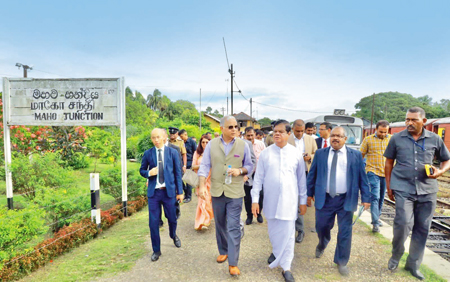
Minister Dr. Bandula Gunawardena, Indian High Commissioner Santosh Jha and Project Director Roshan Munasinghe inspect the Mahawa (Maho) railway station.
At that time, it took eight hours for the Yal Devi Express train and six and a half hours for the inter-city express train to travel from Colombo to KKS. Despite the given schedule, the journey actually took 45 minutes more due to the poor track conditions.
Discussions on a complete refurbishment of the railway line between Mahawa junction (also called Maho) and Omanthai under Indian aid began and related activities were coordinated to carry it out, but it was gradually thrown aside due to the Covid-19 pandemic and was pulled further down the list of priorities.
After the reconstruction of the Northern Railway Line in 2014, Mahawa-Omanthai was included in the railway modernisation agreement related to the Indian loan scheme, and tenders were called in 2019. The construction of the 128 km railway from Mahawa to Omanthai was also given to the Indian State-owned company IRCON.
But it was not implemented from 2019 to 2022. Through the intervention of the Minister of Transport, Highways and Mass Media, Dr. Bandula Gunawardena, Gopal Baglay, who held the post of Indian High Commissioner in Colombo at the time, expressed his wish to start reconstruction immediately under the Indian loan scheme.
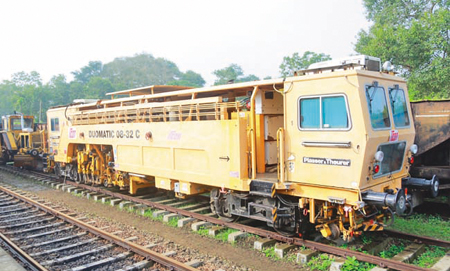
Modern track-laying machinery.
Under the lead of the IRCON Company, the 128 km railway was completely renovated in two phases.
The renovation work began in Medawachchiya and the entire project was to be done at a cost of US$ 91.27 million. In relation to Phase 1, on January 7, 2023, the 61.6 Km railway line from Anuradhapura to Omanthai was completely closed and renovations commenced.
Under that phase, three stations from Anuradhapura to Omanthai, Parasangaswawa, Medawachchiya, and Vavuniya, and all sub-stations, Mihintale Junction, Saliyapura, Medagama, Punewa, Iratteperiakulam and Thandikulam were also modernised.
Test run
After nearly six months, a test run was very successful and after that the train started running again from Colombo. Accordingly, it was possible to reduce the travel time of the Yal Devi to about seven and a half hours. Although it was possible to travel at a speed of 100 km per hour from Anuradhapura to KKS, the speed of the train from Mahawa to Anuradhapura ranged from 5 kmph to 32 kmph due to the poor condition of the track.
Therefore, the real results of the progress achieved by the complete repair of the railway line from Anuradhapura to Omanthai could not be achieved. Therefore, after several months of the restoration of the North-South train service, the work on the railway section from Mahawa to Anuradhapura, which is the second phase, was started on January 7, 2024. That route has now been completely closed.
Before this program began, the Railway Department conducted a Dhamma sermon in front of the Sri Maha Bodhi in Anuradhapura from New Year’s Eve to New Year’s Day (Jan 1). It was carried out under the guidance and initiative of the Minister Dr. Gunawardena, and on January 7, the Mahawa – Anuradhapura railway line modernisation project officially started at the Galgamuwa railway station.
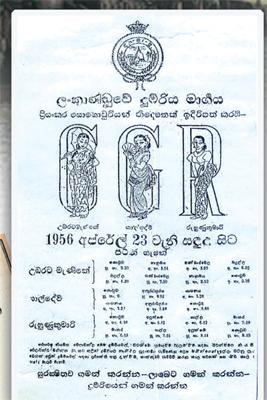
An advertisement announcing the launch of the Yal Devi that appeared in the Silumina in 1956.
The new Indian High Commissioner to Sri Lanka Santosh Jha, First Secretary of the Indian High Commission Irina Thakur, Minister of State for Media Shantha Bandara and other dignitaries attended. Secretary ot the Ministry of Transport and Highways Ranjith Rubasinghe, Railway General Manager H. M. K. W. Bandara and a large number of Government officials including senior officials of Ports and Railways and IRCON representatives were present on the occasion.
The dignitaries travelled by rail bus from Mahawa Junction to view the railway line. There, the railway authorities explained the facts to the Indian High Commissioner about the ancient tablet signal system, which has been in use for more than 100 years since the British era.
The Mahawa – Anuradhapura line improvement project was inaugurated at the Galgamuwa railway station with the participation of all dignitaries and the ceremonial activities were also performed.
The entire railway line from Mahawa Junction to Anuradhapura is to be modernised. Indian special rails will be used for the line, which are stronger and taller than the rails commonly used in Sri Lanka. The old rails will be completely removed, new ground will be prepared, and necessary underground excavations will also be carried out.
Specific needs
Ashoka Munasinghe, Director of the Mahawa-Omanthai railway reconstruction project, says that the Indian experts have identified specific needs after inspecting land and bridge foundations.
“The construction of this line is to be started now and handed over in July, but the request of the Minister Dr. Gunawardena is to hand it over before Poson Full Moon Poya Day. Discussions in this regard have been held with the IRCON Company. “Accordingly, we are trying to finish the full renovation work by May 31 and make the trains ready for running,” Munasinghe said.
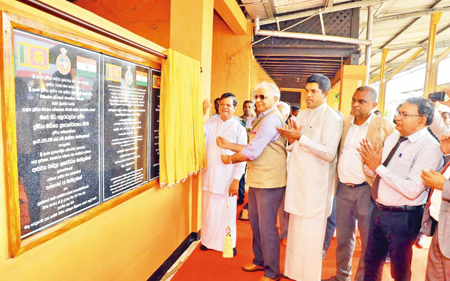
Minister Dr. Bandula Gunawardena and Indian High Commissioner Santosh Jha unveiling a plaque at the Galgamuwa Railway Station to start the renovation project. State Minister of Media Shantha Bandara and Railways General Manager Eng. H.M.K.W. Bandara are also in the picture.
Although the train can theoretically travel at a speed of 120 kmph on this track, Railways will only allow a maximum speed of 100 kmph for safety reasons.
Five new major railway bridges will be established under the renovation program. The railway track will be 500 mm (20 inches) higher than the current one. Therefore, railway stations and crossings should also be modernised. For that, the Department is carrying out work related to railway stations and railway crossings.
The railway line from Mahawa to Anuradhapura is to be equipped with full colour signals. At the same time, the hand signal system (tablet system) currently used will be completely removed. The colour signal system that will be installed on this track is technologically superior to all the railway colour signal systems currently in use in other parts of the country.
Under this modernisation, Ambanpola, Galgamuwa, Senaratgama, Tambuttegama, Talawa and Shavastripura railway stations and the two sub-stations – Randenigama and Anuradhapura New Town – will also be upgraded.
According to the new signalling system, the location of a train can be easily seen and it will no longer be necessary to calculate the speed of the train to get the ‘tablet’ signal at stations where express trains do not stop.
An amount of Rs.4,500 million has already been allocated under Indian Credit Line for the complete modernisation of the colour signalling system. After the reconstruction, it will be possible to travel to Anuradhapura in less than three hours. The travel time of the inter-city express train running from Colombo to Jaffna will be reduced by one and a half hours and the travel time of other express trains including the Yal Devi will be reduced by about two hours. It will go down in history as the fastest train ever in the history of Sri Lanka railways.
Under this project, the length of the loop line (the train stopping line without a platform at major stations) will be increased and extended so that even a train with about 20 carriages can be stopped on that line.
After the completion of the renovation work, the running time of the Northern trains will be reduced by 1 hour 30 minutes for the inter-city express train and 2 hours for other trains including Yal Devi.
The largest development project undertaken by the Government this year is the Mahawa-Anuradhapura Railway Reconstruction Project. Along with these renovations, Galgamuwa, Tambuttegama, and Talawa railway stations will also be given a facelift.
Temporary arrangements
Due to the ongoing renovations, the Northern train will only travel from Colombo to Mahawa, and arrangements have been made to deploy 20 Sri Lanka Transport Board (SLTB) buses from Mahawa to Anuradhapura and Jaffna for passengers travelling to Anuradhapura or Jaffna until the line is fully restored.
According to the Railway General Manager Bandara, four train services have been put into operation between Anuradhapura and KKS. He said that trains will run from Anuradhapura at 8:20 a.m. and 2:30 p.m. to KKS and from KKS to Anuradhapura at 6:00 a.m. and 2:40 p.m. In addition, the Rajarata Rajina train running from Beliatta to Anuradhapura will also run up to Mahawa junction.
He also said that the Yal Devi train will leave Colombo Fort at the same time and ply to Trincomalee and passengers can go to Mahawa by that train and go to Anuradhapura and Jaffna by bus or go to Anuradhapura and reach Jaffna by train again.
Bandara also said that with the development of the Northern Railway, there will be need for re-development again for another 50 years. He also pointed out that through the modernisation of this line, not only Jaffna but also Mannar railway passengers will stand to benefit.
As a passenger ferry service has also started from KKS to India, the train service to the North will be very popular. Similarly, the IRCON Company has also used Sri Lankan technology and labour in the reconstruction of the Northern railway.
Train services are a safe, cheap and comfortable mode of travel between the North and the South of Sri Lanka. Also, by being able to travel to Colombo quickly via train, it will be possible to quickly fulfill the needs of the people of the North, and it will also be possible to bring products of the North to Colombo and the Western Province as well as the transportation of goods and petroleum, if the KKS cement factory is restarted soon, its products can also be brought to Colombo quickly.
Also, since the Palaly airport has been upgraded to international level, the availability of rail and air services through KKS/Palaly as a profitable means of transportation for air travellers will contribute positively to the economy. Above all, it will augment North-South reconciliation, which we have been hoping for more than 30 years. The refurbished Northern Railway will hopefully bring the two communities together, ending divisions and animosity and ushering in a new era for the country.
Translated by Jonathan Frank







